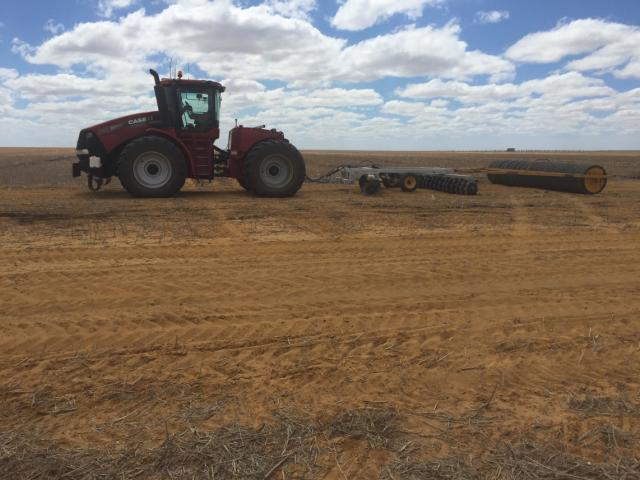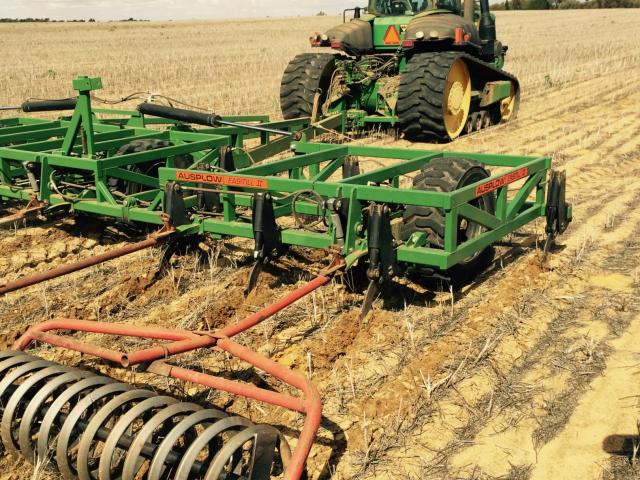Seeding into deep ripped or renovated soils
Achieving good plant establishment after soil renovation can be challenging depending on the resulting soil surface conditions.
Renovation techniques commonly used to address soil compaction and non-wetting soils that can be problematic include deeper deep ripping, mouldboard ploughing, spading or claying.
A survey last year conducted by the Department of Agriculture and Food, Western Australia (DAFWA) and the Mingenew Irwin Group (MIG) found 36% of farmers (out of 20) had issues with plant establishment after deep ripping.
Some of the problems noted by respondents included:
- bar castor wheels bogging.
- the bar sinking in lighter country, resulting in some wheat germinating from 125 millimetres in the deeper spots.
- uneven establishment; seeding in drying topsoil conditions increased erosion risk, therefore seeding ripped country was delayed until after rain.
- rollers were not heavy enough to lightly pack the surface (although melons and couch didn’t help).
Solutions used by survey respondents included:
- dropping the tyre pressure in the bar wheels.
- buying a bar with independent depth control.
- seeding at 45 degrees to the ripping direction, however this practice increases the area of the paddock re-compacted.
There is still further work to be done to determine the optimal management techniques for seeding into soft soil.
The following information suggests some current strategies to help reduce plant establishment issues.
Surface packing and finish
It is difficult to manage seeding depth if there is an uneven soil surface after ripping.
This can be compounded with the bar sinking into loose soil.
Towing a weighted roller behind the ripper helps produce a firm, even seed bed, breaking up any soil clods often produced when ripping heavier soil types.
There are some commercially available rollers or some farmers have designed their own.
Angle iron welded to large diameter steel pipe that can be filled with water to add weight or truck tyre rollers are just two variations in rollers manufactured to achieve a level surface.
Coil packers can help level the paddock after ripping although if ripping deeper than 30 centimetres or in moist conditions then a heavier weighted roller is likely to be required.
Many farmers have reported topsoil inclusion plates leaving large furrows in moist soil conditions, if these furrows cannot be removed by using a roller then it is advisable to take the plates off.
Rollers will affect the amount of stubble remaining standing so it is important to assess the erosion risk before ripping particularly in very sandy soils.
Wind erosion risk is reduced with 50% cover present at the beginning of autumn.
In very sandy soils with high erosion risk deeper ripping and topsoil slotting may provide a significant benefit by maintaining cover compared to the stubble burial achieved by mouldboarding and spading, however deep ripping is not a method to alleviate non-wetting.
Therefore if non-wetting is an issue on these soil types other management techniques may be required such as avoiding dry seeding, increasing seed rate or using a banded wetting agent.
Some farmers will choose not to rip paddock if stubble cover is considered too low.
The soil surface may also be left cloddy after soil renovation using a plough or claying particularly where subsoil with a higher clay content has been brought to the surface.
Some options to break up the clods include using a roller, prickle chain, disc harrows or offset discs.
If clods are particularly large offset discs may be the best option.
Surface crusting
Surface crusting is not usually a problem after deep ripping but it can occur with delving or after soil inversion using a mouldboard plough or spading.
Crusting can occur as a result of bringing up subsoil with higher clay content and burial of organic matter.
In the first season crusting can impede emergence.
Larger seeded crops (e.g. cereals, grain legumes) are better able to tolerate variations in seeding depth due to uneven surface following any tillage, however cereals have the greater capacity to recover from any wind erosion damage.
Herbicide activity
Herbicide activity can increase after soil inversion and deep soil mixing as result of reducing topsoil organic matter and water repellence.
While this may benefit weed control there can also be considerable crop damage from pre-emergent herbicides which can interact with seeding depth and other issues to reduce establishment.
Reducing herbicide rates and using safer pre-emergent herbicide options can significantly reduce this risk.
Seeding strategies
The following strategies have been found to help seeding into soft soils:
- Ground-following seeding equipment controlling the depth of each row with a press wheel-based mechanism can be an advantage seeding into uneven ground as the seeding depth is adjusted as required.
- Wider press wheels - may be required to reduce sinkage burying the seed deeper or reducing a bulldozing effect if the weight of the bar carried on the press wheels is too heavy.
- Light seeding bars - some growers who are undertaking large areas of deep ripping or soil amelioration have setup light seeding bars specifically for seeding soft soils, these are commonly 12 metres.
- Shallow working seeding points - can help minimise the sowing depth compared with deep working points. Some growers have even used worn or cut off knife points.
- Broadcast seed spreading - for soils that have been deep ploughed, broadcast spreading of cereal seed onto wet soil and then pressed down with coil packers can also be used for cover in the first year.
- Cross seeding - grower experience has shown seeding offset to the main working direction avoids plant establishment issues. However while this does show good results and may be required if all other strategies fail, if it can be avoided the return on ripping investment will last longer. Seeding at 45 degrees nearly doubles the trafficked area of the paddock and eighty percent of compaction occurs in the first pass. Before cross seeding consider why this option is needed; is it overcoming a non-wetting issue, high stubble load, or reducing bogging caused by bar design? Perhaps there are some management options that can be taken to avoid it in the future such as alleviate the non-wetting, modify the bar setting or change press wheels for example.
Wheel tracks
Deeper or rutted wheel tracks are another cause of variable seed placement.
This can occur in high traffic lanes that get deeper over time from multiple passes particularly in wet conditions, or where re-compaction post ripping has occurred by machinery if wheel tracks are not matched.
If the main bar wheels run in the depressed wheel tracks and there is no independent depth control the rows near the wheel track can be sown too deeply.
A similar issue can occur where the soil surface has lifted during the renovation process.
Maintaining wheel tracks by infilling the ruts will help reduce these issues and minimise the risk of erosion.
There are commercially available machines for renovating wheel tracks or some farmers have engineered their own.

Bogging in soft soils after deeper ripping can be a problem that results in uneven seeding depth.
The problem is reduced if machinery is matched in a controlled traffic farming (CTF) system and the wheel tracks are not ripped.
However bogging can still occur if not all the machinery runs on the main wheel tracks, such as the bar or air cart wheels.
Reducing the tyre pressure in the bar wing wheels may help.
A possible strategy for air carts in very soft, boggy areas could be only half filling the cart and maybe reducing the tyre pressure in the front smaller tyres on tow behind carts.
Bogging may also be an issue for machinery that falls off the firm wheel tracks into wet soft soil particularly when travelling at faster speeds for spraying.
Some options include leaving a wider unripped wheel track, using wider tyres, or some farmers have found running a shallow ripping tine in line with the main wheel tracks forms a shallow channel that the sprayer can track in.
Conclusion
At the time of ripping or ploughing it is important to check the finish on the soil surface so adjustments can be made as you go to prevent challenges at seeding.
A poorly ameliorated soil can be very costly to fix.
More research is required to fine tune techniques to achieve good plant establishment after soil renovation to fully capitalise on the benefits of improved soil condition increasing plant root access to water and nutrients.
Acknowledgements
DAFWA’s GRDC funded projects DAW243 “Minimising the effect of compaction on crop yield” and DAW244 "Agronomic options for improved crop performance on water repellent soil in WA".
Mingenew Irwin Group GRDC RCSN project MIG00016-A "Deeper deep ripping and water use efficiency".
For more information contact:
- Bindi Isbister, Development Officer, Geraldton on +61 (0)8 9956 8532.
- Wayne Parker, Research Officer, Geraldton on +61 (0)8 9956 8511.
- Stephen Davies, Research Officer, Geraldton on +61 (0)8 9956 8515.


